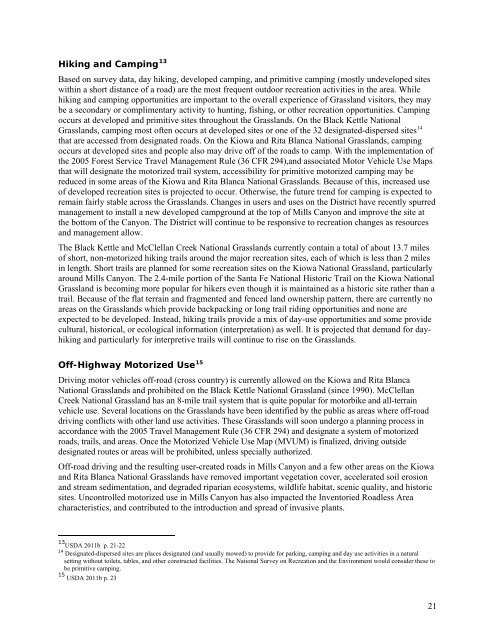Comprehensive Evaluation Report
Comprehensive Evaluation Report
Comprehensive Evaluation Report
Create successful ePaper yourself
Turn your PDF publications into a flip-book with our unique Google optimized e-Paper software.
Hiking and Camping 13<br />
Based on survey data, day hiking, developed camping, and primitive camping (mostly undeveloped sites<br />
within a short distance of a road) are the most frequent outdoor recreation activities in the area. While<br />
hiking and camping opportunities are important to the overall experience of Grassland visitors, they may<br />
be a secondary or complimentary activity to hunting, fishing, or other recreation opportunities. Camping<br />
occurs at developed and primitive sites throughout the Grasslands. On the Black Kettle National<br />
Grasslands, camping most often occurs at developed sites or one of the 32 designated-dispersed sites 14<br />
that are accessed from designated roads. On the Kiowa and Rita Blanca National Grasslands, camping<br />
occurs at developed sites and people also may drive off of the roads to camp. With the implementation of<br />
the 2005 Forest Service Travel Management Rule (36 CFR 294),and associated Motor Vehicle Use Maps<br />
that will designate the motorized trail system, accessibility for primitive motorized camping may be<br />
reduced in some areas of the Kiowa and Rita Blanca National Grasslands. Because of this, increased use<br />
of developed recreation sites is projected to occur. Otherwise, the future trend for camping is expected to<br />
remain fairly stable across the Grasslands. Changes in users and uses on the District have recently spurred<br />
management to install a new developed campground at the top of Mills Canyon and improve the site at<br />
the bottom of the Canyon. The District will continue to be responsive to recreation changes as resources<br />
and management allow.<br />
The Black Kettle and McClellan Creek National Grasslands currently contain a total of about 13.7 miles<br />
of short, non-motorized hiking trails around the major recreation sites, each of which is less than 2 miles<br />
in length. Short trails are planned for some recreation sites on the Kiowa National Grassland, particularly<br />
around Mills Canyon. The 2.4-mile portion of the Santa Fe National Historic Trail on the Kiowa National<br />
Grassland is becoming more popular for hikers even though it is maintained as a historic site rather than a<br />
trail. Because of the flat terrain and fragmented and fenced land ownership pattern, there are currently no<br />
areas on the Grasslands which provide backpacking or long trail riding opportunities and none are<br />
expected to be developed. Instead, hiking trails provide a mix of day-use opportunities and some provide<br />
cultural, historical, or ecological information (interpretation) as well. It is projected that demand for dayhiking<br />
and particularly for interpretive trails will continue to rise on the Grasslands.<br />
Off-Highway Motorized Use 15<br />
Driving motor vehicles off-road (cross country) is currently allowed on the Kiowa and Rita Blanca<br />
National Grasslands and prohibited on the Black Kettle National Grassland (since 1990). McClellan<br />
Creek National Grassland has an 8-mile trail system that is quite popular for motorbike and all-terrain<br />
vehicle use. Several locations on the Grasslands have been identified by the public as areas where off-road<br />
driving conflicts with other land use activities. These Grasslands will soon undergo a planning process in<br />
accordance with the 2005 Travel Management Rule (36 CFR 294) and designate a system of motorized<br />
roads, trails, and areas. Once the Motorized Vehicle Use Map (MVUM) is finalized, driving outside<br />
designated routes or areas will be prohibited, unless specially authorized.<br />
Off-road driving and the resulting user-created roads in Mills Canyon and a few other areas on the Kiowa<br />
and Rita Blanca National Grasslands have removed important vegetation cover, accelerated soil erosion<br />
and stream sedimentation, and degraded riparian ecosystems, wildlife habitat, scenic quality, and historic<br />
sites. Uncontrolled motorized use in Mills Canyon has also impacted the Inventoried Roadless Area<br />
characteristics, and contributed to the introduction and spread of invasive plants.<br />
13 USDA 2011b p. 21-22<br />
14 Designated-dispersed sites are places designated (and usually mowed) to provide for parking, camping and day use activities in a natural<br />
setting without toilets, tables, and other constructed facilities. The National Survey on Recreation and the Environment would consider these to<br />
be primitive camping.<br />
15 USDA 2011b p. 23<br />
21
















